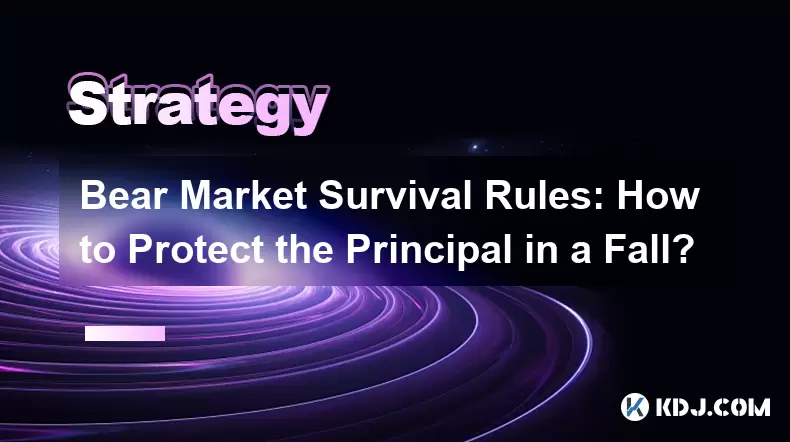-
 bitcoin
bitcoin $123963.239194 USD
1.37% -
 ethereum
ethereum $4529.082464 USD
1.07% -
 xrp
xrp $2.983640 USD
0.71% -
 tether
tether $1.000287 USD
0.02% -
 bnb
bnb $1179.874393 USD
2.99% -
 solana
solana $230.633678 USD
1.55% -
 usd-coin
usd-coin $0.999835 USD
0.03% -
 dogecoin
dogecoin $0.254240 USD
1.34% -
 tron
tron $0.341176 USD
0.15% -
 cardano
cardano $0.842285 USD
0.52% -
 hyperliquid
hyperliquid $48.537896 USD
-0.86% -
 chainlink
chainlink $21.863092 USD
-0.84% -
 ethena-usde
ethena-usde $0.999743 USD
-0.07% -
 sui
sui $3.579561 USD
-0.18% -
 stellar
stellar $0.403418 USD
2.67%
Bear Market Survival Rules: How to Protect the Principal in a Fall?
Protect your principal in a crypto bear market by diversifying, setting stop-loss orders, using dollar-cost averaging, maintaining liquidity, and employing hedging strategies.
May 28, 2025 at 08:08 am

In the volatile world of cryptocurrencies, navigating through a bear market can be a daunting challenge for investors. Protecting your principal during such times is crucial to ensuring that you can continue to participate in the market once conditions improve. This article will guide you through essential strategies and practices to help you safeguard your investments during a downturn.
Understanding Bear Markets in Cryptocurrency
A bear market is characterized by a prolonged period of falling prices and widespread pessimism among investors. In the cryptocurrency space, bear markets can be particularly harsh due to the high volatility and speculative nature of digital assets. Recognizing the signs of a bear market early can give you a head start in adjusting your investment strategy. Key indicators include sustained price declines, increased market volatility, and negative sentiment across social media and news platforms.
Diversification as a Defensive Strategy
One of the most effective ways to protect your principal during a bear market is through diversification. By spreading your investments across various assets, you can mitigate the risk of significant losses in any single investment. In the context of cryptocurrencies, this could mean investing in a mix of established coins like Bitcoin and Ethereum, as well as smaller altcoins and even stablecoins.
- Allocate your portfolio across different types of cryptocurrencies.
- Consider investing in stablecoins like USDT or USDC, which are pegged to fiat currencies and offer stability.
- Look into decentralized finance (DeFi) projects that might offer yield opportunities even during downturns.
Setting Stop-Loss Orders
Stop-loss orders are another tool that can help you protect your principal. A stop-loss order automatically sells your asset when its price falls to a certain level, limiting your potential losses. Setting stop-loss orders requires careful consideration of market conditions and your risk tolerance.
- Determine your stop-loss levels based on your investment strategy and the volatility of the asset.
- Monitor and adjust your stop-loss orders as market conditions change.
- Be aware of the potential for slippage during highly volatile periods, which can result in your order executing at a worse price than expected.
Dollar-Cost Averaging
Dollar-cost averaging (DCA) is a strategy that involves investing a fixed amount of money at regular intervals, regardless of the market's performance. This approach can help you avoid the pitfalls of trying to time the market and can lead to a lower average cost per unit over time.
- Choose a fixed amount to invest at regular intervals, such as weekly or monthly.
- Stick to your schedule even during market downturns to benefit from lower prices.
- Adjust your investment amount if necessary, but maintain the consistency of your investments.
Maintaining Liquidity
In a bear market, maintaining liquidity is essential. Having a portion of your portfolio in easily accessible assets can provide you with the flexibility to take advantage of buying opportunities or to cover unexpected expenses without having to sell your investments at a loss.
- Keep a portion of your portfolio in cash or stablecoins.
- Avoid over-leveraging your positions, as this can lead to forced liquidations during market downturns.
- Regularly review your liquidity needs and adjust your holdings accordingly.
Emotional Discipline and Long-Term Perspective
Emotional discipline is crucial during a bear market. Panic selling can lead to significant losses, as it often results in selling at the bottom of the market. Maintaining a long-term perspective and sticking to your investment strategy can help you weather the downturn and potentially benefit from the eventual recovery.
- Stay informed but avoid emotional reactions to short-term market fluctuations.
- Focus on the fundamentals of your investments rather than daily price movements.
- Seek support from a community of investors to help maintain your resolve during tough times.
Risk Management and Position Sizing
Effective risk management is essential for protecting your principal in a bear market. This includes understanding your risk tolerance and adjusting your position sizes accordingly. Smaller position sizes can help you manage risk more effectively, as they limit the impact of any single investment on your overall portfolio.
- Assess your risk tolerance and adjust your position sizes to align with it.
- Use position sizing calculators to determine the appropriate amount to invest in each asset.
- Regularly review and rebalance your portfolio to ensure it remains aligned with your risk management strategy.
Utilizing Hedging Strategies
Hedging strategies can provide an additional layer of protection for your principal during a bear market. In the cryptocurrency space, this might involve using derivatives like futures and options to offset potential losses in your spot positions.
- Explore futures and options markets to understand how they can be used to hedge your investments.
- Consider shorting overvalued assets as a way to profit from declining prices while protecting your long positions.
- Be aware of the risks associated with derivatives and ensure you fully understand the products before using them.
Frequently Asked Questions
Q: How long do bear markets in cryptocurrency typically last?A: The duration of bear markets in cryptocurrency can vary significantly, with some lasting a few months and others extending over a year or more. Historical data shows that bear markets in the crypto space can be shorter than those in traditional markets, but they can also be more severe.
Q: Can I make money during a bear market in cryptocurrencies?A: Yes, it is possible to make money during a bear market by employing strategies such as short selling, investing in stablecoins, or taking advantage of lower prices through dollar-cost averaging. However, these strategies carry their own risks and require careful management.
Q: Should I completely exit the market during a bear market?A: Exiting the market entirely during a bear market is a personal decision that depends on your investment goals and risk tolerance. Some investors choose to hold through the downturn, while others may decide to move to cash or stablecoins to preserve capital. It's important to have a clear strategy in place and to avoid making impulsive decisions based on fear.
Q: How can I psychologically prepare for a bear market?A: Psychological preparation for a bear market involves setting realistic expectations, maintaining a long-term perspective, and avoiding emotional reactions to short-term market movements. Engaging with a supportive community of investors and regularly reviewing your investment strategy can also help you stay disciplined during challenging times.
Disclaimer:info@kdj.com
The information provided is not trading advice. kdj.com does not assume any responsibility for any investments made based on the information provided in this article. Cryptocurrencies are highly volatile and it is highly recommended that you invest with caution after thorough research!
If you believe that the content used on this website infringes your copyright, please contact us immediately (info@kdj.com) and we will delete it promptly.
- BlockDAG, DOGE, HYPE Sponsorship: Crypto Trends Shaping 2025
- 2025-10-01 00:25:13
- Deutsche Börse and Circle: A StableCoin Adoption Powerhouse in Europe
- 2025-10-01 00:25:13
- BlockDAG's Presale Buzz: Is It the Crypto to Watch in October 2025?
- 2025-10-01 00:30:13
- Bitcoin, Crypto, and IQ: When Genius Meets Digital Gold?
- 2025-10-01 00:30:13
- Stablecoins, American Innovation, and Wallet Tokens: The Next Frontier
- 2025-10-01 00:35:12
- NBU, Coins, and Crypto in Ukraine: A New Yorker's Take
- 2025-10-01 00:45:14
Related knowledge

Practical parameter settings for a Bitcoin multi-timeframe moving average system
Sep 18,2025 at 10:54pm
Optimizing Timeframe Combinations for Bitcoin Trading1. Selecting appropriate timeframes is crucial when building a multi-timeframe moving average sys...

How can I filter out false breakouts in Dogecoin high-frequency trading?
Sep 22,2025 at 01:00am
Understanding False Breakouts in Dogecoin Trading1. A false breakout occurs when Dogecoin's price appears to move beyond a defined support or resistan...

Techniques for identifying tops and bottoms in the Bitcoin on-chain NVT model
Sep 20,2025 at 07:54pm
Understanding the NVT Model in Bitcoin Analysis1. The Network Value to Transactions (NVT) ratio is often described as the 'P/E ratio' of the cryptocur...

What does the surge in open interest in Bitcoincoin futures mean?
Sep 20,2025 at 11:18pm
Understanding the Surge in Dogecoin Futures Open Interest1. A surge in open interest within Dogecoin futures indicates a growing number of active cont...

How can I use the Ethereum USDT premium to gauge market sentiment?
Sep 18,2025 at 11:55pm
Understanding the Ethereum USDT Premium1. The Ethereum USDT premium refers to the price difference between USDT (Tether) traded on Ethereum-based plat...

What should I do if Ethereum staking yields decline?
Sep 20,2025 at 06:18am
Understanding the Causes Behind Declining Ethereum Staking Yields1. The Ethereum network transitioned to a proof-of-stake consensus mechanism with the...

Practical parameter settings for a Bitcoin multi-timeframe moving average system
Sep 18,2025 at 10:54pm
Optimizing Timeframe Combinations for Bitcoin Trading1. Selecting appropriate timeframes is crucial when building a multi-timeframe moving average sys...

How can I filter out false breakouts in Dogecoin high-frequency trading?
Sep 22,2025 at 01:00am
Understanding False Breakouts in Dogecoin Trading1. A false breakout occurs when Dogecoin's price appears to move beyond a defined support or resistan...

Techniques for identifying tops and bottoms in the Bitcoin on-chain NVT model
Sep 20,2025 at 07:54pm
Understanding the NVT Model in Bitcoin Analysis1. The Network Value to Transactions (NVT) ratio is often described as the 'P/E ratio' of the cryptocur...

What does the surge in open interest in Bitcoincoin futures mean?
Sep 20,2025 at 11:18pm
Understanding the Surge in Dogecoin Futures Open Interest1. A surge in open interest within Dogecoin futures indicates a growing number of active cont...

How can I use the Ethereum USDT premium to gauge market sentiment?
Sep 18,2025 at 11:55pm
Understanding the Ethereum USDT Premium1. The Ethereum USDT premium refers to the price difference between USDT (Tether) traded on Ethereum-based plat...

What should I do if Ethereum staking yields decline?
Sep 20,2025 at 06:18am
Understanding the Causes Behind Declining Ethereum Staking Yields1. The Ethereum network transitioned to a proof-of-stake consensus mechanism with the...
See all articles










































































